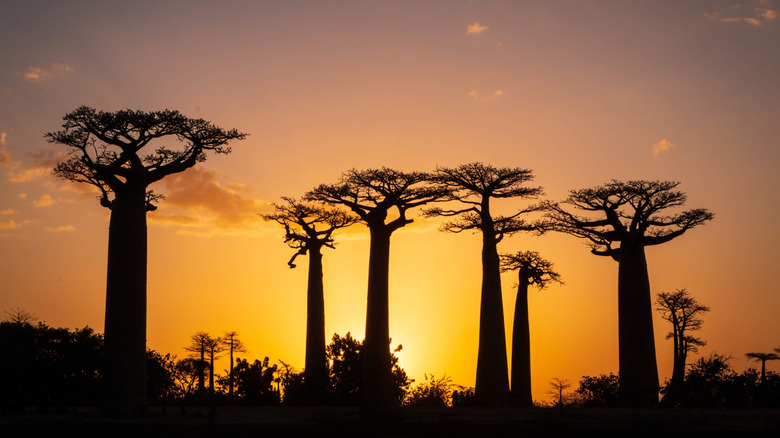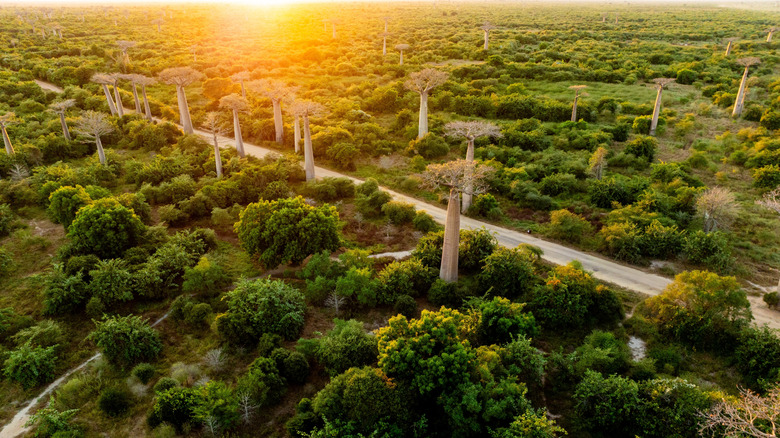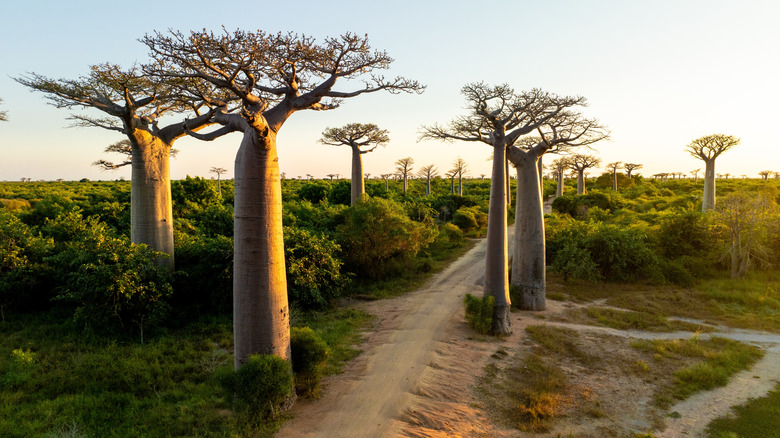One Of The World's Best Skylines Is A Towering Baobab Boulevard Kissed By Gold Madagascar Sunsets
Madagascar, one of the largest islands on the planet, is called the "Great Red Island" thanks to its distinctive red soil. The only spot in the world you can see lemurs in the wild and sometimes nicknamed "the Eighth Continent" for its unique landscapes and wildlife that exist nowhere else, Madagascar is one of the best places to see baobab trees, an icon of Africa known as the "Tree of Life." It is, in fact, considered the "home of baobabs," as six of the nine subspecies of the tree are native to the island (two more subspecies are native to mainland Africa, and one is endemic to Australia).
Baobab trees get their nickname from the huge variety of uses for their bark and fruit, from medicine to food to paper, and their own ability to live for centuries — as long as 3,000 years! In addition, they're a keystone species of the African grasslands, slowing soil erosion, storing water, and providing sustenance. Baobabs are woven throughout the fabric of many African cultures and are often present in legends. The very appearance of the baobab tree is impressive and unique; the smooth, sturdy trunks appear to be roots-up towards the heavens, the source of the nickname of Africa's "upside-down tree." Although they're slow-growing, they still manage to grow to great heights, up to 100 feet (30 m).
You can find baobab trees all over the Great Red Island, but the specific destination that draws tourists from all over is the Allée des Baobabs, or Avenue of the Baobabs, in western Madagascar. This unassuming dirt road is flanked by baobab giants, which, especially at sunset, light up one of the world's most impressive horizons. Who needs a city skyline when Mother Earth can do it so much better?
Madagascar's Allée des Baobabs (Avenue of the Baobabs)
Experiencing the Avenue of the Baobabs is one of the top things to do in Madagascar, especially at sunset. Located inland from the beach town of Morondava on Madagascar's western coast, the short dirt road is dwarfed by dozens of Grandidier's baobabs, the most iconic baobab subspecies. Some of these trees may be 1,000 years old, with trunks that are 150 feet (45 m) thick. Although these majestic trees stand tall above the landscape, they were once part of a thriving forest. Unfortunately, the massive deforestation that has plagued Madagascar over the years has left these trees as solitary stalwarts. Luckily, the Avenue of the Baobabs became Madagascar's first natural monument in 2007, which will hopefully help protect these sacred trees for future generations.
Like many baobab trees, those found on the Avenue of the Baobabs are the source of many legends. The local Malagasy myth says that baobab trees once became too assured of themselves, thus angering the gods, who uprooted the trees and replanted them upside down, with the roots pointing up to the heavens. When Arab seafarers first encountered the trees on the avenue over 1,000 years ago, they thought the devil himself had ripped the trees out and replanted them, again upside down.
Sunrise or sunset is the best time to visit the Avenue of the Baobabs, when the sun casts a golden light on the trees and extends their long shadows. At sunset, the eastern side of the small nearby lake adds an extra dimension of color and silhouettes in the water. One thing is for sure: you'll want to bring your camera to capture these views, although only in person can you truly experience the air of mystery that surrounds the majestic trees.
Avenue of the Baobabs: How to get there and where to stay
Madagascar's Avenue of the Baobabs is one of those once-in-a-lifetime vacation destinations you don't want to miss out on. Unfortunately, there's no getting around it: Madagascar is a challenging destination, so it's not the easiest bucket-list item to check off. Roads are rough and distances are vast, and there are few in-country flights. The largest airport, Itavo International in Antananarivo (Madagascar's capital), is a full 14-hour drive from the Avenue of the Baobabs. However, the domestic airport in Morondava, the closest town to the Avenue, has regular one-hour flights to the capital. From Morondava, it's about 40 minutes to the Avenue. If you drive, there's a parking area with a small fee; alternatively, you can take a taxi or join one of the many tours. While at the Avenue, you can stop at the gift shop near the southern entrance to purchase local handicrafts or some baobab jam.
Most of the nearest hotels are in Morondava, which is ideal if you'd like to stay on the beach. However, if you're dreaming of having a safari-like experience, try the more luxurious Kimony Resort Hotel. It's also near some of the area's best beaches, and the Kirindy Reserve (Réserve Forestière de Kirindy) is within easy access if you're hoping to spot lemurs and other unique Madagascar wildlife. When visiting either the Avenue of the Baobabs, the Kirindy Reserve, or even the budget-friendly nearby island of Mauritius, make sure to support local, sustainable tourism resources to support the conservation of region's delicate ecosystems.


